What Fly Fishing Gear Do I Need?
By John Miller.
Fly fishing has its own unique equipment and fishing tackle. If you are a beginner, then it can be overwhelming on what fly fishing gear you need. So we have put together a list of items you need.
This is also handy for the intermediate fly fisherman, as you can go by this list, so you don’t forget anything as well.
We have divided the fishing gear list into two sections.
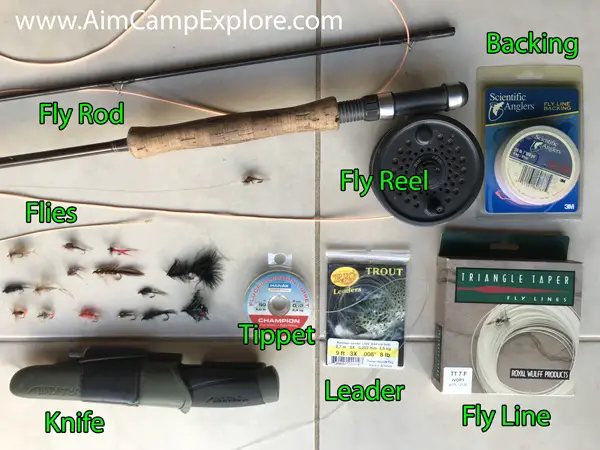
The first one is what you definitely need to get started. The second section is optional items. That you may get down the track later on, if you decide fly fishing is for you.
We will also list the items at the top of the article, then go through each item in more in detail further down the article about how and whys and also tips on the fly gear. Also what you might use as an alternative if you haven’t got that item.
What equipment do you need for fly fishing?
Essential fly fishing gear.
Fly rod.
Fly reel.
Fly line and backing.
Leader and tippet.
Assorted flies.
Knife.
Fishing license.
Optional fly fishing gear to take.
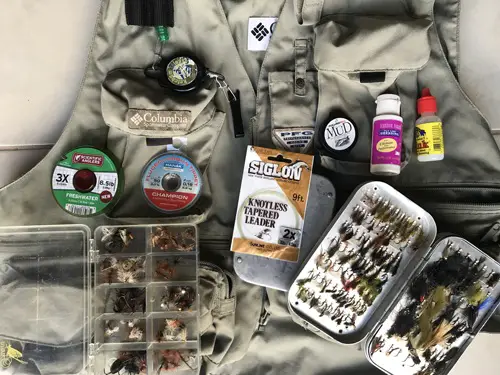
Fly fishing vest.
Fly box.
Fishing waders.
Wading belt.
Fishing line nippers or line scissors.
Flashlight or headlamp.
Spools of tippet material in different poundage’s.
Spare leader.
Spare spool of fly line in sinking or intermediate lines.
Tippet rings.
Split shot.
Forceps, fishing pliers, Leatherman tool or multi tool.
Wide brimmed hat.
Polaroid sunglasses.
Rain jacket.
Landing net.
Dry fly floatant.
Fishing sink paste. (Fishing line Mud.)
Fly line dressing.
Strike indicators.
Notepad and pen.
Drink bottle.
Cloth to hold the fish and clean hands.
Ruler to measure the fish.
Insect repellant.
Fishing Priest.
GPS, Map and compass.
First aid kit.
Snacks.
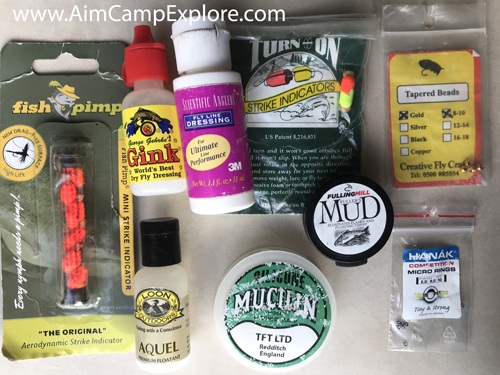
Clothing
Long sleeve shirt.
Rain proof jacket.
For cold weather, thermal underwear and thermal top.
Gloves.
Good pair hiking socks.
Optional – beanie.
Buff.
In the car
Cooler box.
Ice.
Extra drinks and food.
Spare torch and batteries.
Cell phone recharger.
Extra warm clothing.
Here is the list of fly fishing gear needed in more detail.
Fly rod.
A good fly rod helps cast the line with minimal effort, accuracy and helps present the fly.
Fly rods are long, at around 8’ 6” or 9 foot or longer. A 9 foot rod is a popular choice and lots of manufactures offer this length.
The weight of the fly rod should match your fly line weight, fishing conditions and size of fish targeted. This number will be listed on the rod, as an example 6 w. on the rod. This means a 6 weight fly rod and you should use a 6 weight fly line. (This size is ideal for medium trout and other fish.)
The fly line and rod weight goes from 3 weight all the way up to 12 weight. The smaller size is suited for small fish. The bigger size is for bigger fish species targeted.
A smaller weight like a 3 weight is used for smaller fish on smaller streams and ponds.
An 8 weight might be used for bigger trout, salmon and bass, or also in windy conditions.
The 8 weight up to 12 weight might be used for saltwater fishing for big fish species.
A fly rod can also suit two size fly lines, such as on the rod it is marked as 6/7 weight. This means you could either use a 6 weight fly line or a 7 weight line. Some anglers might use a heavier line or lighter line depending on the fly rods characteristic, conditions or angler’s preference.
Fly rods can have different actions, like slow action, medium action, medium / fast action and fast action. This is basically how responsive the rod is and how much the rod will flex when casting it. The medium action fly rod might be a starting choice for the beginner.
A fast action loads the fly line quickly and can have a lot of power, which can mean distance. But a fast action fly rod can be harder to cast for the beginner.
A slow action rod can help present the fly delicately and accurately, but not ideal for achieving distance or for windy days. (Depending on the angler’s skill.)
A fly rod can be broken into pieces, ranging from 1 full length piece, 2 pieces, 3 and 4 pieces.
If you plan to travel a lot, consider a fly rod that packs into 4 pieces or so. This makes them easier to travel with.
What is the best fly rod brand out there? This will depend on the angler’s choice, skill and budget. But some of the better known brands are: Sage, Loomis, Scott, Orvis, Thomas & Thomas, Redington, R.L. Winston Rod Company, Hardy and Fenwick to name a few. These companies have a lot of fly rods to choose from, and at different price brackets and models.
For information on fly combos for beginners, click on Best Fly Rod And Reel For Beginners.
Fly reel.
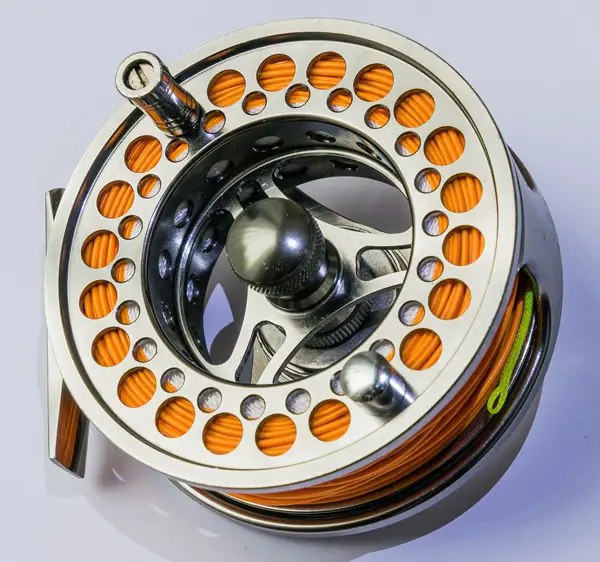
A fly reel basically holds the fly line and backing line. It also helps you strip line out and wind the line in when playing a fish.
A fly reel isn’t as complicated in design as a bait caster or spinning reel, but still needs to be robust.
The size of the fly reel should match the weight / storage capacity of the fly line, otherwise you will run out of room on the reel. An example if you try and put an 8 weight fly line on a reel designed for a 5 weight fly line, it won’t fit.
Qualities of the reel and price very tremendously. Especially for a quality saltwater fly reel, as they are put under a lot of pressure and exposed to salt water.
With some fly reels come with an extra spool, so you can load up a spare fly line on the spool. An example is you might have a floating fly line on your reel and rod. A spare sinking or intermediate fly line is on the spare fly reel spool in your fly vest for other fishing conditions.
Fly line and backing.
A fly line works with the fly rod to help cast and turn over the leader and tippet on the water to present the fly to the fish.
A fly line is thicker in diameter than normal fishing line and is tapered.
The fly line has several elements too it, such as:
Fly line weight. (Size.) Such as #6 wt. fly line.
Density. The function of the fly line, like if it floats, slowly sinks or sinks quickly.
Taper or design. Forward taper, double taper, etc.
Color.
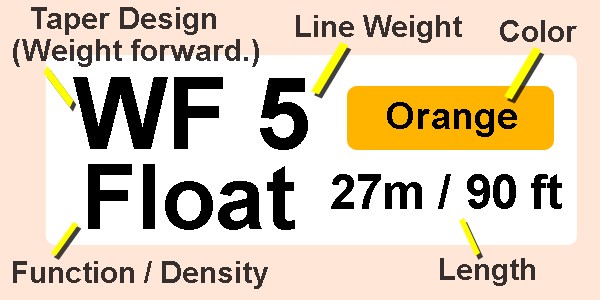
Make sure your fly line weight, matches your rod, otherwise it won’t cast as well. Such as a 5 weight fly line should match a 5 weight fly rod.
Click on How To Choose A Fly Line for more detailed information on fly line weights and functions.
A popular line density is a floating fly line which is versatile for a variety of fishing and species such as trout. You can use this line for fishing dry flies, wets, streamers and nymphs.
A floating fly line has its limitations and for deeper waters were the fish are feeding close to the bottom, or for fast flowing currents a sink tip or sinking fly line might be a better choice.
An intermediate line sinks roughly around the same sink rate and depth as a normal fishing line. The intermediate fly line might be used for saltwater fishing or medium to deep waters.
There are several types of fly line designs with different tapers. As an example, a forward taper has the weight and thicker part of the fly line towards the front end, which helps cast bigger flies and cut through the wind easier.
A double taper has thicker section of fly line in the middle and tapers thinner at both ends. It can be used for presenting flies more delicately on the water.
Brands – A known quality brand of fly line, like Scientific Anglers, Air Flo, Cortland, Rio and Royal Wolf, will last longer and cast easier.
A cheap low quality fly line won’t cast as efficiently because of the coating and design.
The backing is tied to the reel. The fly line should have backing attached to it, so if the fish runs and strips the fly line out, you don’t lose your fly line or the fish.
Leader and tippet attached.
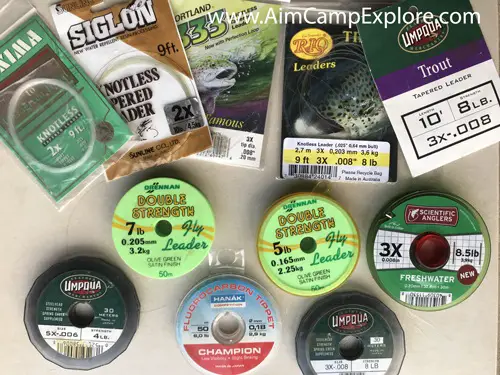
A leader connects to the fly line and is like fishing line, but tapers down in size. The leader might be from 7 to 9 feet in length.
The thinner end of the leader is tied to the tippet, which is a thinner piece of fishing line. The fly is tied to the tippet.
Overall the leader and tippet help present the fly to the fish. It also helps keep the fly a distance away from the heavy fly line.
If the fly was connected straight to the fly line, the fish would easily see the thick fly line and swim away from it.
Length and breaking strength of the leader and tippet will depend on the fish species you are after. Such as fly fishing for small pan fish you would use a lighter line. For fly fishing for large bass, you use a heavier poundage line.
For more information on tippets go to – What Is A Tippet In Fly Fishing?
Assorted fly fishing flies.
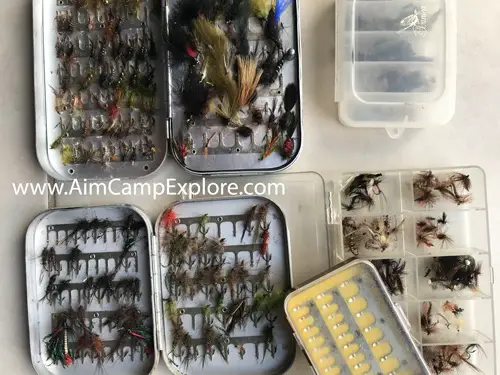
You need a range of flies, so if the fish are feeding on one source of food, you can match that size, characteristic and appearance.
Fly fishing flies imitate a wide range of food groups to the fish like; terrestrial insects, aquatic insects, amphibians and crustaceans to name a few.
The fishing flies might typically represent food like: beetles, Mayfly’s, tadpoles, frogs, leeches, dragon fly’s, dragonfly nymphs, damsel flies, damsel fly nymphs, crawfish, midges, crickets, grasshoppers, bait fish, fish eggs, caddis moths, stone flies, spiders, grubs, earthworms and snails.
Flies are also divided into general patterns, like: dry flies, wet flies, nymphs, streamers and saltwater flies.
For information on the various types of flies, click on – Different Types Of Fly Fishing Flies.
For starting out, you might have a few nymph patterns, wets and dries, until you learn what fish food sources are around in the area.
Check out for more information – Fly Fishing Tips And Tricks.
Knife.
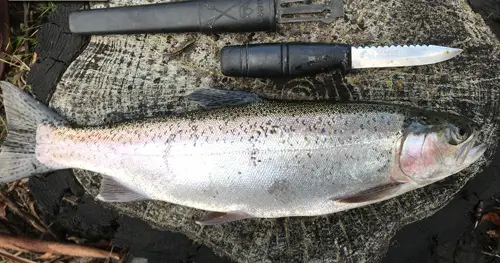
A knife is essential from everything to cutting fishing line, to help cleaning the fish, to filleting the fish.
A pocket knife or fixed blade knife will do the trick for general use and cleaning the fish. However, it probably won’t be great for filleting the fish, but can do in a pinch.
The difference between a filleting knife and general knife is the filleting knife has a long, thin and flexible blade. This helps precisely slice between the fish’s skin and meat.
A good brand of knife are the Mora knives. (MoraKniv.) Made in Sweden, these are some of the best knives in the world for general use, hunting, fishing and bushcraft knifes.
Mora has a range of inexpensive, exceptional quality blades that are sharp out of the box and ideal for fishing.
Fishing license.
Some people avoid buying a fishing license, but the funds help anglers and fish in several ways.
Depending on the region and state, a fishing license helps pay for research into fish and provides stocking fish in waterways.
In some areas it may even help maintain boat ramps and piers and funds fisheries and wildlife officers and park rangers.
Overall the money spent on a license helps preserve the future of fish for our young generation of anglers.
If you are going to fish in Texas, check out – How Much Is A Texas Fishing License?
For anglers considering California, check out the cost buy by clicking on – How Much Is A California Fishing License?
Optional fly fishing gear in more detail.
Fly fishing vest.
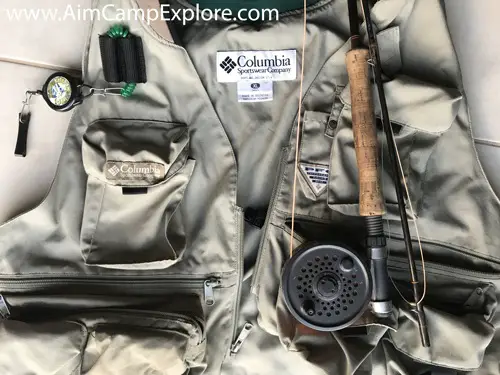
The fly vest has several pockets and compartments on it. Which is ideal for carrying extra fly boxes, tippet material, fishing line nippers and Polaroid sunglasses, etc.
The vest makes it easy to access equipment easy while fly fishing in the water or walking along the bank stalking fish.
A good fly fishing vest makes it easier to carry heavy fly gear, as it distributes the weight evenly across the shoulders.
A fly fishing vest is normally short in length, so when you are wading in the water, you don’t get your fishing tackle wet.
For beginners who don’t know if fly fishing is for them, or they don’t want to spend money on a vest, you can use a carry bag or back pack to carry the fly gear. But a fly vest makes it easier to carry gear and changing tackle and flies on the water.
Another option to the fly vest is a fanny pack or bum bag. For saltwater fly fishing I like this option, especially in hot weather, as a fly vest can get too hot to wear.
For fly fishing from a boat or kayak, you can get some good fishing life jackets / PFD (Personal Flotation Devices.) that have plenty of pockets to hold your fly fishing gear like fly boxes and spare tippet material.
I put my cell phone and car keys in a small dry bag and put this in my fishing life jacket when kayak fly fishing, or in a boat. That way if it did get wet, it would be safe and dry.
Fly boxes.
A fly box helps organize the flies for easy selection.
It can also separate the flies, so they don’t get tangled up. It also helps them dry so they don’t rust.
You can get a wide range of fly boxes, everything from plastic, metal to beautiful made wooden fly boxes. They can hold everything from dry flies, wets, nymphs to large saltwater flies, etc.
Containers also vary in the way they hold the flies, such as magnets, foam slits, small containers, dividers and hook holders.
If you are a beginner to fly fishing, a small plastic Tupperware container can hold some flies, until you get some fly boxes.
Fishing waders.
Waders are like rubber boots, but go higher up. They help the angler stay dry and warm when fishing in the water.
(Well most times, I always seem to go too deep and the water goes over the top of the waders and I get wet.)
Fishing waders come in designs like thigh or hip, waist and chest waders. As an example thigh waders are similar to rubber boots, but come up higher just to the thigh. Full length waders, called chest waders are used for wading in deeper waters.
Waders also come in two main designs, with boots and without. With built in boots in them, they are called bootfoot waders. The ones without boots are called stockingfoot waders.
With stockingfoot waders you use a separate wading boot over them. Just like hiking boots, put over socks.
If you are hiking a long distance to get to the fishing area, or wading in rocky rivers a pair of stockingfoot waders with separate wading boots would be a better choice. As they are more comfortable and stable.
Waders are made with different materials and each one has positives and negatives around it. As an example, neoprene waders are good for colder waters, but not good for hot weather.
In hot weather fishing waders can be uncomfortable to wear as they don’t breathe very well, depending on the material.
If you are starting out fly fishing and are just testing the waters, so to speak, a pair of rubber boots (also called wellies or galoshes) can be okay for shallow areas. Or if you are just fishing from the river bank, rubber boots are fine and also offer some protection from snakes and prickles.
Generally though, the fish always seem out of casting reach, so the fly fisherman has to go a bit deeper in the water and it makes the waders useful.
Some good fly fishing wader brands are Simms, Orvis, Patagonia and Columbia waders.
Click on Best Fishing Waders for more information.
Wading belt.
A wading belt goes around waist or chest waders, so if you fall in the water, the waders don’t fill up with water.
When waders are full of water, they are extremely heavy and cumbersome and make it difficult to get back out of the water.
Always be careful when fishing streams with strong currents, or lakes with deep holes when wading.
Ideally don’t use waders in a boat and always use a life jacket / PFD when in a boat.
Fishing line nippers or line scissors.
Nippers, clippers and fishing line scissors are ideal for cutting fishing line. (Don’t use your teeth.)
Fishing line nippers are great for fly fisherman for cutting the tag end of the tippet line precisely close to the fly.
Scissors or a knife can be difficult to get close to eye of the fly, so nippers are easier to use. You can also use them on cutting flies with loose threads, or trimming feathers or fur that look unsightly on the fly.
For a beginner a pair of small scissors can cut the line without buying anything extra. However a pair of good fishing line nipper’s makes cutting the line quicker and easier.
A retractable holder makes using the nipper easier to reach and use, without loosing them.
For the 10 best fishing nippers, click on Best Fishing Nippers for the top picks.
Flashlight or headlamp.
A flashlight is a good idea for safety when walking back towards the vehicle, so you can see the trail.
While you can use your cell phone light, you are better off preserving the battery life for emergency calls. (Like calling your fishing partner and telling them the big one just got away. Or if you are a bad friend, telling him how good the fishing is, why he is working!)
A headlamps is ideal for fishing at dawn, dusk or night fishing, as you have both hands free to tie the fly on and change tippet material in bad light.
Remember to check the torch or headlamp that it is working before you head out and carry spare batteries for it.
A keyring flashlight like the Olight I3E EOS makes a good spare torch and is small to carry. See the in-depth review on this great little torch by clicking on – Olight I3E EOS Flashlight Review.
Spools of tippet in different poundage’s.
Other fly gear you will need for fly fishing is different poundage tippet material. This is useful for changing tippet size to match the fishing conditions.
An example is if you are fishing in the morning with no wind, the water is crystal clear and the fish are feeding on tiny midges. You can change to a thin 2, 3 or 4 pound tippet that makes it harder for the fish to see the line. It also can present the fly more delicately on the water, as opposed to a thicker 8 pound tippet that will land on the water with more disturbance and could scare the fish away.
On the other hand you might be fly fishing at night in murky waters and strong windy conditions. In the area are big trophy trout and snags in the water, so you change to a 8 pound tippet, so if you get a big trout on, you have less chance of breaking of the line.
The thicker stronger tippet line also makes casting and presenting the fly into the wind a little bit easier.
Spare leader.
In case you get broken off, or your leader gets abraded and damaged, carry a spare leader.
Make sure you know how to attach it to the fly line.
Spare spool of fly line in sinking or intermediate lines.
If you use a floating fly line, a spare line in intermediate, sink tip or sinking fly line is very useful for fishing deeper waters.
Perhaps you are fly fishing from a dam wall, deep drop off, or from a boat. A sinking line makes it quicker to get down to where the fish are feeding and swimming about.
Have the spare line all kitted out with the leader attached, etc.
Tippet rings.
Micro tippet rings helps connect the leader to the tippet. I love these little things as it saves you cutting the leader every time you replace the tippet.
One negative of these tiny ring is you need great vision or a 1,000,000 power microscope (Joking, I don’t really know if that is a real thing or not. But you have to have great eyesight or glasses) to tie them on. Don’t lose them or they disappear forever, because they are so small.
Most tippet rings are packaged in with a safety pin type device to hold them together.
Split shot.
Split shot is like a tiny weight or fishing sinker. Instead of threading fishing line through the hole, like on a sinker, with split shot you crimp the weight on the line.
If you don’t have any bead head flies, or weighted flies, then split shot can work for fishing deeper.
Placing some split shot on the tippet, or even right in front of the fly, can help get your fly down quicker in deeper waters or currents.
On the negative side of things, split shot can affect your casting, but split shot is versatile for the size of it. Be careful you don’t crimp the split shot too tight on the tippet, otherwise it can damage and weaken the line.
Forceps, fishing pliers, Leatherman tool or multi tool.
Leatherman tools, fishing pliers and similar tools like them have dozens of uses when fishing. Like: remove a hook, flatten a barb or help cut wire leaders or tighten screws on a reel.
Forceps can be used to safely remove the hook from the fish, without getting close to the fish sharp teeth.
A pair of long nose pliers can work if you haven’t got forceps or fishing pliers.
Wide brimmed hat.
Avoid the baseball cap, as a wide brimmed hat will shade the side of your face more than a cap. It also reduce glare better from the sun and helps you spot feeding fish.
(I know the baseball cap, does look better.)
When casting, a wide brimmed hat also protects you from a stray cast, where the hook can hit you in the face. Especially if you are a fly fishing beginner, or casting on a windy day.
Polaroid sunglasses.
I didn’t include Polaroid sunglasses as essential fly fishing gear in this article, however, they come close to being on the list, as they have very important uses for fishing like:
Protect your eyes from the sun and glare, reduce wind and grit. For saltwater fishing, they help reduce sand or salt spray.
As well as protect you from the elements and weather, Polaroid sunglasses help protect your eyes from a stray cast and hook, especially with a hat.
Combined with a wide brimmed hat, Polarized sunglasses help you see in clear water to spot fish swimming about. They are also good for boating where snags like stumps and rocks are in the water.
If you ever get a chance to do, “Polaroiding” using the Polarized sunglasses in clear waters, looking for trout swimming about, make sure you try it as it is exciting fly fishing. Your heart will jump when you spot a trout cruise up and take your fly.
Rain jacket.
A spare jacket is always a good idea, even if the weather is fine, as it can soon change. Also you might stay out fishing later then intended and it can get cold.
Landing net.
The landing net helps land the fish when caught. Another benefit of a net is you can keep the fish in the net and water, so it’s less stressed when getting the hook out.
For the beginner, you don’t need a dedicated short handled fly fishing net, although one does make it easier. Having said this for many years, my father and I just fly fished without a net and landed the fish by hand, or dragged it onto the bank gently if it was going to be eaten.
Dry fly floatant.
When you false cast the fly you dry it out a bit and you can deliberately dry the fly this way. However, sometimes you dry fly just gets waterlogged, so dry fly floatant helps the dry fly or emerger pattern, become more buoyant and ride higher on the water’s surface.
You can get gels, liquids and sprays that you just apply a drop or two on the fly to help it.
You can also smear some on your tippet to help it float better.
Fishing sink paste. (Mud)
Sinking paste is very handy to have in you fly vest. You might be using a wet fly, that doesn’t sink, so a bit of paste can help it fish the bottom quicker.
You can also put it on your tippet and leader to help it sink. You might have used a silicone Mucilin floatant on the line when dry fly fishing earlier on, so this helps reverse the affect and sink it.
Fly line dressing.
Fly line dressing can help clean and make the fly line slicker and easier to cast.
To learn how to clean the fly line, visit the article on – How to Clean A Fly Fishing Line.
Strike indicators.
A strike indicator is a visible small material that is tied to the end of the fly line. It is normally used when nymphing. When the fish takes the fly under the water, it pulls down the leader and fly line with the strike indicator.
You can use bits of fluro yarn or small bits of foam. Or buy a manufactured strike indicator.
I normally use a buoyant colorful dry fly that is easily visible and tie my nymph on a dropper to that. Having two flies also increase your catching of catching a fish. (However, it also increases the chances of a tangle.)
Notepad and pen.
A note pad and pen is handy for recording your observations and catch when fishing. Alternatively use your cell phone notes to record the information.
You can record what size and type of fish caught, or what the fish are feeding on. What fly you caught the fish on. The conditions, like wind direction, temperature, water temperature, insects about, water levels, etc.
Some anglers might even record what cycle the moon is at, such as full moon.
Drink bottle.
It is easy to get carried away fishing and forget to hydrate, so a drink bottle is a must.
For hot areas take more water. Before you leave the vehicle, have a fair bit of water to hydrate.
Cloth to hold the fish and clean hands.
An old cloth, rag or bandanna is a good idea as it has many cleaning uses, like to wash the mud or slime off your hands. Or to help gently hold a fish to remove the hook.
Tape to measure the fish.
The olden days of weighing the fish are nearly gone, especially for catch and release anglers. So a fishing tape or ruler, combined with a photo, can still show proof that the big one didn’t get away.
The ruler can also help measure the fish and make sure it is legal size for the species and area fished.
Insect repellant.
Mosquitos, flies, gnats and other annoying and biting insects can be an issue when fishing. So some insect repellent might be worth including.
Fishing Priest.
A fishing priest is a small baton used to dispatch fish. It can be made from wood or metal.
Carrying a fishing priest is a personal choice for some anglers.
GPS, Map and compass.
For fishing wilderness waters, a GPS should be taken. In case the GPS breaks, a map and compass should always be taken as well. If you are not sure on using a compass proficiently, visit – How To Use A Compass with step by step directions and illustrations.
If fishing off the beaten track or in remote places, then a PLB (Personal Locator Beacon) is worth having. Like if you have a wilderness emergency, like a fall or twist you ankle. The PLB are getting smaller, lighter and more reliable and cheaper each year.
If you are in a boat, then an EPIRB (Emergency Position Indicating Radio Beacon. Emergency Personal Locater Beacon) should be on board. Remember the life jackets / PFD.
Remember to tell your friend or partner, exactly where you are going fishing, so if an accident happens, people know where you are.
For extra safety equipment to include when you are hiking to your fishing spot, click on – What should I take in a survival kit?
First aid kit.
A personal first aid kit is a good idea as you are dealing with fish that might have sharp spines or teeth. Also you might have a mishap with the fishing hooks and knives.
Walking along the uneven bank with holes, or along the rocky river bed, you might twist your ankle. So an elastic bandage, or compression bandage or two is a good idea.
Snacks.
Before you know it, you have been fishing for hours and you end up hungry, so some snacks or food is a good idea to bring along.
Trail mix, fruit and chocolate bars seem to go well as a snack when fishing.
Try to avoid food where you constantly have to touch it bare, as you might have fish slime, mud and algae on your hands from the water and fish.
Clothing.
Regardless if it is hot weather a loose long sleeve shirt and long pants is good to wear stream side. If you wear shorts and t-shirt, you can get sun burnt or insects and creepy crawly’s can bite you easier.
Walking along the bank is safer with long pants (or waders) than shorts, as snakes may be active around the water’s edge looking for frogs and food.
A warm coat or rain proof jacket can make the difference between staying longer fishing, or packing up and going home early because it was cold or wet.
I have included a rain jacket twice / coat twice in the list, once in the optional gear and also included it in the clothing section. This is because of the importance of having appropriate clothing outside. Also one jacket might be a rain proof type shell, the other a more thermal insulation jacket, like a soft shell jacket to keep you warm.
For cold weather, thermal underwear and thermal top, combined with fleece or wool layers can keep you warmer. Wool and fleece have both positives and negatives to each material, both are good for fishing. Fleece can dry quicker when wet though.
For retrieving the fly, your hands strip the wet fly line and can get very wet and cold. So waterproof gloves, or fishing gloves are a good idea to keep your dexterity and feeling.
I use an old pair of scuba diving wetsuit gloves, with the pointer fingertip cut off and thumb. This allows feeling the line when the fish bites and helping tie flies on and tackle.
For hot weather a light pair fishing gloves can stop the back of your hands from getting sunburnt.
If you do walk a long distance to your fishing spot, a good pair hiking socks will prevent blisters and be more comfortable walking.
Another optional to consider taking for cold weather is a beanie, woolen cap, skull cap or balaclava. This is good for night time and cooler mornings when fishing.
Buffs, scarves and neck warmers can keep your neck area warm and great on a cold morning fishing.
For saltwater fly fishing on hot windy days, a fishing buff stops the wind, salt and sand. Combined with some Polaroid sunglasses and hat, you can fish more comfortable.
Don’t underestimate the value of layering your clothing when fishing. This allows you to concentrate on the fishing and not being distracted by the cold or wet when fly fishing.
I am writing a separate article about what to wear when fly fishing, which will be finished shortly.
In the vehicle.
A cooler box with ice is a good idea to store your catch.
Or if you normally fish catch and release, with no fish brought home, it can keep the drinks cold or extra food.
Some spare batteries, recharger and a spare flashlight is also useful, in case you forget to bring them with your fishing gear.
A cell phone recharger might be with you on the water, or in the vehicle, depending how long you plan to go fishing.
Extra warm clothing back at the vehicle can help keep you warm if you accidentally go for a swim when fishing. Extra clothing gives you more options to layer and keep warm.
Extra equipment.
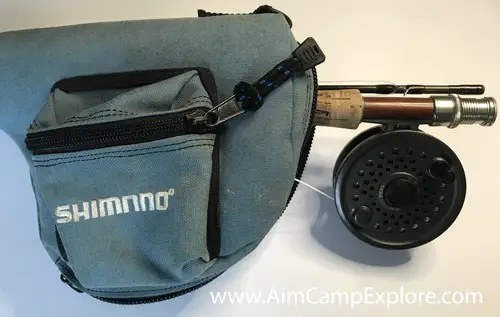
Other items you might need or use are: Fly rod tube, fly rod sock / cover, fly reel cover, fishing float tube and fins, hook de-gorger, insect catch net and fly tying gear. (Some fly fisherman will tie flies bank side to imitate a fish food source they haven’t got a pattern for.)
Conclusion – What fly fishing gear do I need?
We hope this article has solved you question of what fly fishing equipment you need to take with this list and information.
As you can see, you can go as simple with basic fly gear essentials, or have as many accessories as you like.
The beauty about fly fishing is you can improvise and use other fishing gear for the additional accessories. Or perhaps even go the whole hog and get most items. Either way, fly fishing is what you make it regardless of the gear you choose to bring.
Extra Resources:
What to Look For In a Fishing Float Tube?
